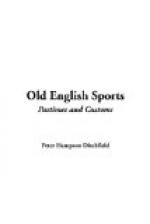The decoration of churches and houses with flowers just risen from their winter sleep, the practice of always wearing some part of the dress new on Easter Day, all seem to have had their origin in the holy lessons which cluster round the festival of the resurrection. An old writer tells us that it was the custom in some churches for the clergy to play at handball at this season; even bishops and archbishops took part in the pastime; but why they should profane God’s house in this way we are at a loss to discover. The reward of the victors was a tansy-cake, so called from the bitter herb tansy, which was supposed to be beneficial after eating so much fish during Lent. Of the various kinds of games with balls I propose to treat in another chapter.
At Easter there were numerous sports in vogue in different parts of the country. In olden times almost every county had its peculiar sport, which was regarded as a monopoly of that district. People did not work so hard in those days, and seem to have had more time and energy for ancient pastimes. Many of these old games have entirely vanished; others have left their old neighbourhoods, and received a hearty welcome all over the country. Berkshire and Somersetshire were the ancestral homes of cudgel-play, quarter-staff, and single-stick. Skating and pole-leaping were the characteristic sports of the fen country. Kent and Sussex were famous for their cricket; the northern counties for their football. Scotland rejoiced in golf, curling, and tossing the caber; while Cumberland and Westmoreland, Cornwall and Devon, were noted for their vigorous and active wrestlers. Curling, tossing the caber[8], and wrestling have clung to their old homes; but the other sports have wandered far and wide, and are no longer confined to their native counties.
At Easter the local favourite sport was renewed with zest and eagerness, and almost everywhere foot-races were run, the prize of the conqueror being a tansy-cake. Stoolball and barley-brake were also favourite games in this month, as Poor Robin says in his Almanack for 1677. Barley-brake seems to have been a very merry game, in which the ladies took part, and of which we find some very bright descriptions in the writings of some old English poets. The only science of the pastime consisted in one couple trying with “waiting foot and watchful eye” to catch the others and bear them off as captives.
An old writer thus describes a water tournament, which seems to have been a popular pastime among the youths of London at Easter—“They fight battels on the water. A shield is hanged upon a pole (this is a kind of quintain) fixed in the midst of the stream. A boat is prepared without oars, to be carried by the violence of the water, and in the fore-part thereof standeth a young man ready to give charge upon the shield with his lance. If so be he break his lance against the shield, and do not fall, he is thought to have performed a worthy deed. If so be that,




